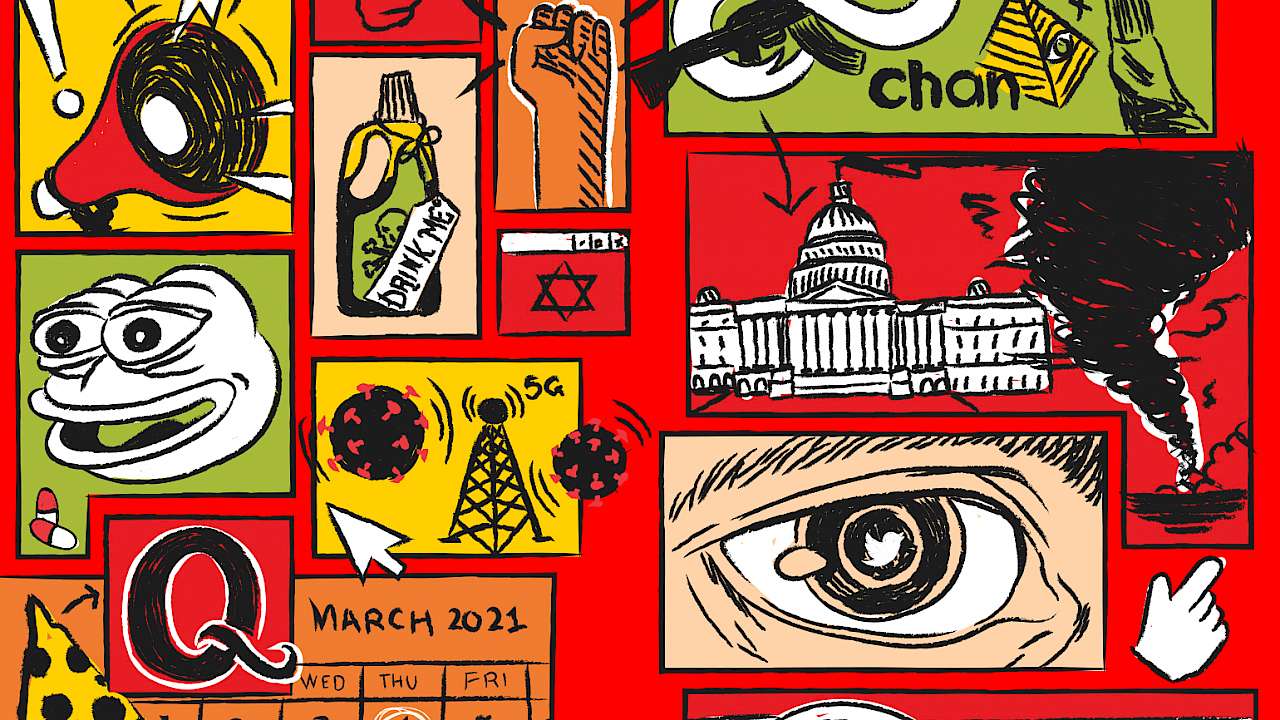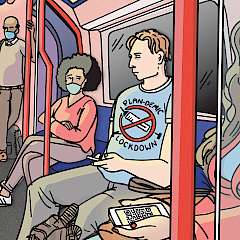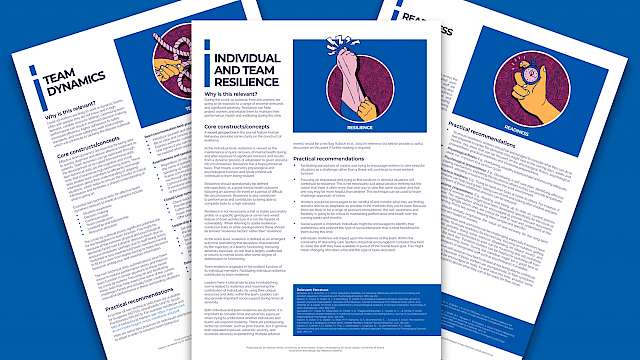The not-so-new New World Order
The COVID-19 pandemic has upended the normative social order of democratic societies in profound ways: lockdowns, public health mandates, a range of restrictions on movement and behaviour, and the rapid development of new-generation vaccines. This disruption has occurred amid an environment of risk and uncertainty that threatens peoples’ sense of security, stability, and resilience. The rise of pandemic-led conspiracy thinking has therefore been predictable.
There is a well-established relationship between conspiracy narratives and the sense of threat, particularly concerning system identity threat, or the view that society is fundamentally changing. QAnon influencers, for example, quickly harnessed their conspiracy movement’s anti-government, ‘Deep State’ narrative of corrupt, shadowy elites to fit with how states around the world were responding to the pandemic’s public health threats.
However, QAnon’s dark prophesies of a New World Order that would upend civilisation is not new, drawing together a pastiche of familiar, pre-existing militant narratives based on anti-Semitism, white nationalism, anti-vaccination, and anti-technology discourse.
Some of these older militant narratives have long been associated with violent action against minorities and violent resistance to the state. It is, therefore, unsurprising that the rise of pandemic-inspired conspiracist movements has been escalated and capitalised on by violent extremist movements across the board.
Europol has warned that COVID-19 will continue to escalate violent extremist threats in various countries, increasing tolerance for violence in response to pandemic-induced stressors. This runs alongside evidence that ideologically diverse violent extremist networks are exploiting pandemic-related vulnerabilities through online propaganda and recruitment efforts.
As our AVERT Research Network submission to Australia’s parliamentary inquiry on extremist movements and radicalism argues, the extension of government authority and curtailing of individual liberties during a public health emergency have been consistently reframed by extremists as instruments of social control, government corruption, and state illegitimacy, accelerating what Ehud Sprinzak (1991) terms the ‘transformational delegitimation’ of democratic societies and institutions.
New gateways to violent extremism
While QAnon influencers were predictably nimble in exploiting gateway online anti-child abuse and exploitation networks to grow their impact, pandemic-inspired intersection of lifestyle and wellness, violent extremism, and conspiracy networks has been more novel.
In Australia, the former chef and dietary wellness influencer Pete Evans posted the neo-Nazi ‘sonnenrad’ or ‘black sun’ swastika for his many online followers, a symbol appropriated by the Nazis to signal the rebirth of Aryanism. Other wellness influencers have also energetically sought to monetise the surge of interest in anti-authority conspiracies by promoting product-based resistance to public health measures.
The weaponisation of COVID-19
The promotion of conspiracies and disinformation can be understood as a form of attack. For those who seek to escalate violent conflict, accelerate civil unrest, and enhance social and political polarisation, COVID-19 has been a swiftly weaponised gift, for example, by encouraging followers to deliberately spread COVID-19 as a means of hastening the collapse of civilisation or the elimination of hated others. These efforts have been significantly aided by the shift to extensive online social interaction as well as information-gathering to make sense of the upheaval.
For those who seek to escalate violent conflict, accelerate civil unrest, and enhance social and political polarisation, COVID-19 has been a swiftly weaponised gift
This is particularly the case for young people who are arguably bearing a disproportionate pandemic-related burden in terms of disrupted schooling, dwindling or precarious employment, isolation from face-to-face culturally diversified social settings, and mental health and housing challenges (Lowe, 2021). Under these circumstances, the vulnerability of young people – already a generation of digital natives – to the online social harms of violent extremist conspiratorial ideologies can intensify.
Addressing the intersection of COVID-19 and extremist ideologies
A key question raised by the impact of the pandemic on drivers toward violent extremism is whether these impacts are likely to be acute or chronic.
Will the cessation or moderation of the pandemic, driven by increased global vaccination rates and the restoring of individual liberties and movement, see extremist conspiracy uptake subside? Or will the longer-term social, economic, and political impacts of the pandemic, which may well outlast the immediate public health crisis, provide fertile ground for continuing political and social polarisation that extremists can channel toward violent action?
Will the cessation or moderation of the pandemic see extremist conspiracy uptake subside? Or will COVID-19’s longer-term impacts provide fertile ground that extremists can channel toward violence?
While we may not be able to answer this question yet, we should be prepared for both scenarios. A key response for policymakers is to recognise and address:
- The role that conspiratorial thinking plays in processes of radicalisation
- The emergence of conspiracist movements as critical extremist actors (AVERT, 2021)
- Whether strategies for inoculating or ‘pre-bunking’ against conspiracist-extremist appeals might be effective (Banas and Miller, 2013; Braddock, 2019).
Our approach needs to become part of, but also go beyond, preventing violent extremism (PVE) strategy and programming. Policy settings need to redress:
- The post-truth environment in which conspiracist thinking flourishes
- The economic inequalities that fuel its potency
- The social divisions that nurture its narratives
- The technological affordances that drive its dissemination
- All of these are critical areas of investment in mitigating how violent extremist movements can weaponise COVID-19.
Read more
References
- AVERT Research Network. 2021. Submission to Parliamentary Joint Committee on Intelligence and Security Inquiry into Extremist Movements and Radicalism in Australia. February. https://www.aph.gov.au/Parliamentary_Business/Committees/Joint/Intelligence_and_Security/ExtremistMovements/Submissions
- Banas, J. A. and Miller, G. 2013. Inducing resistance to conspiracy theory propaganda: testing inoculation and metainoculation strategies. Human Communication Research 39(2), 184–207. https://doi.org/10.1111/hcre.12000
- Braddock K. 2019. Vaccinating against hate: Using attitudinal inoculation to confer resistance to persuasion by extremist propaganda. Terrorism and Political Violence. https://doi.org/10.1080/09546553.2019.1693370
- Centre for Resilient and Inclusive Societies. 2021. Submission to Parliamentary Joint Committee on Intelligence and Security Inquiry into Extremist Movements and Radicalism in Australia. February. https://www.aph.gov.au/Parliamentary_Business/Committees/Joint/Intelligence_and_Security/ExtremistMovements/Submissions
- Europol. 2021. European Union Terrorism Situation and Trend Report 2021 (TESAT). June. https://www.europol.europa.eu/activities-services/main-reports/european-union-terrorism-situation-and-trend-report-2021-tesat
- Federico, C. M., Williams, A. L., Vitriol, J. A. 2018. The role of system identity threat in conspiracy theory endorsement. European Journal of Social Psychology 48(7): 927–328
- GNET (Global Network on Extremism and Technology). 2020. What is QAnon? https://gnet-research.org/2020/10/15/what-is-qanon/
- Lowe, P. 2021. Young people and violent extremism in the COVID-19 context. ASPI Counterterrorism Yearbook 2021. Canberra: Australian Strategic Policy Institute, 101–106. https://www.aspi.org.au/report/counterterrorism-yearbook-2021
- Khalil, L. 2021. The impact of natural disasters on violent extremism. ASPI Counterterrorism Yearbook 2021. Canberra: Australian Strategic Policy Institute, 107–112. https://www.aspi.org.au/report/counterterrorism-yearbook-2021
- Khalil, L. 2020. Cross-promotion. GNET Insights. July. https://gnet-research.org/2020/07/22/cross-promotion/
- Silke A. 2020. COVID-19 and terrorism: Assessing the short- and long-term impacts. Pool Re Solutions Report, 5 May. https://www.poolre.co.uk/wp-content/uploads/2020/05/COVID-19-and-Terrorsim-report-V1.pdf
- Sprinzak, E. (1991). The process of delegitimation: towards a linkage theory of political terrorism. Terrorism and Political Violence 3(1), 50–68. https://doi.org/10.1080/09546559108427092
- Wilson, J. 2020. The neo-Nazi symbol posted by Pete Evans has a strange and dark history. The Guardian. 24 November. https://www.theguardian.com/world/2020/nov/24/the-neo-nazi-symbol-posted-by-pete-evans-has-a-strange-and-dark-history
Further reading
- Amarasingam, A. and Argentino, M.-A. 2020. The QAnon conspiracy theory: A security threat in the making? CTC Sentinel 13(17), 37–44
- Amarasingam, A. 2019. The impact of conspiracy theories and how to counter them: Reviewing the literature on conspiracy theories and radicalisation to violence. In A. Richards (ed). Jihadist Terror: New Threats, New Responses. London: I. B. Tauris/Bloomsbury, 27–40
- Berger, J.M., 2018. Extremism. Cambridge, MA: MIT Press
- Federal Bureau of Investigation. 2019. Anti-government, identity based, and fringe political conspiracy theories very likely to motivate some domestic extremists to commit criminal, sometimes violent activity. U//LES FBI Bulletin. Phoenix Field Office. Phoenix, AZ: Federal Bureau of Investigation, 30 May
Copyright Information
As part of CREST’s commitment to open access research, this text is available under a Creative Commons BY-NC-SA 4.0 licence. Please refer to our Copyright page for full details.
IMAGE CREDITS: Copyright ©2024 R. Stevens / CREST (CC BY-SA 4.0)







